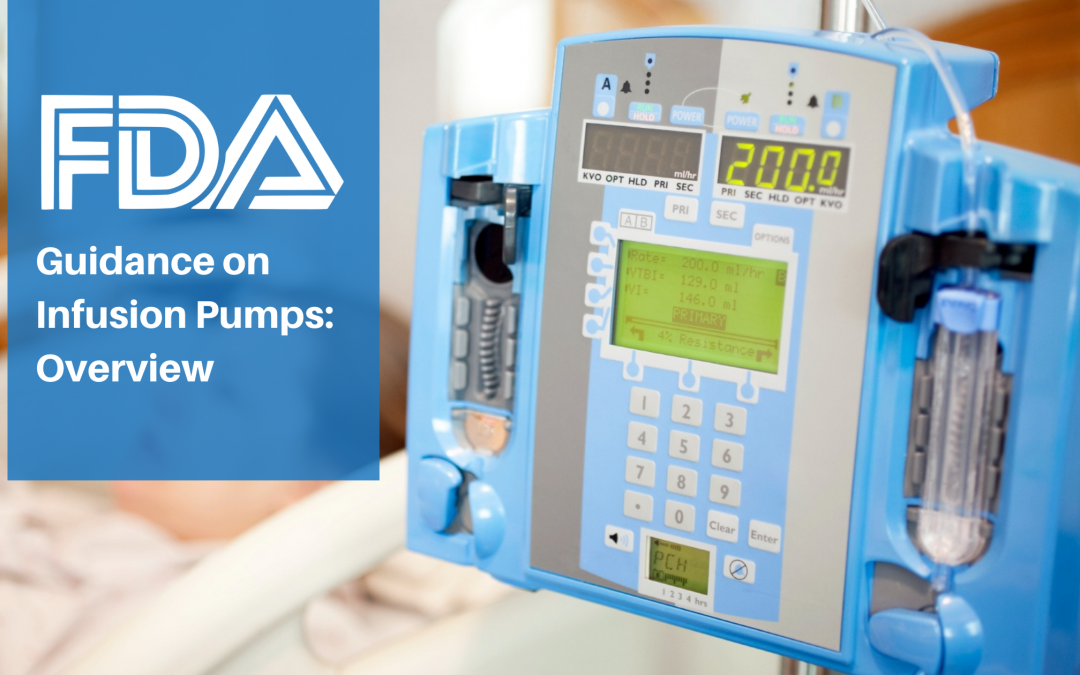The Food and Drug Administration (FDA or the Agency), the US regulating authority in the sphere of healthcare products, continuously develops and publishes guidance documents dedicated to various medical devices. In these documents, the FDA addresses the most important issues related to the applicable regulatory framework and provides additional clarifications and recommendations to be considered by the medical device manufacturers and other parties involved.

Table of Contents
It is important to mention that due to the legal nature of guidance documents issued by the FDA, the provisions contained therein are non-binding, and an alternative approach could be applied, provided such an approach complies with the current legislation and has been agreed with the Agency before being implemented.
There are several guidance documents and policies dedicated to infusion pumps. For instance, the regulatory matters related to these devices are addressed in the appropriate FDA Enforcement policy or the FDA Emergency use authorization (EUA), describing the special temporary and extraordinary measures introduced by the authority in order to expand and ensure the availability of such devices during the public health emergency associated with the outbreak of the Coronavirus Disease 2019 (COVID-19) caused by the virus “SARS-CoV-2” or the “novel coronavirus.” At the same time, the basics of the applicable regulatory framework for infusion pumps are described in the FDA guidance on infusion pumps’ total product life cycle published by the authority earlier in December 2014.
Regulatory Background
The present guidance is intended to provide medical device manufacturers with additional recommendations to be taken into consideration when preparing premarket submissions for infusion pumps. Additionally, the document highlights specific aspects to be addressed throughout the whole product life cycle.
Infusion pumps are medical devices intended for use in a healthcare facility to pump fluids into a patient in a controlled manner, where the term “fluids” stands for FDA approved drugs and licensed biological products. It is also important to mention that the scope of the present guidance covers infusion pumps intended to be used by laypersons outside healthcare facilities under the supervision of a healthcare professional. The applicable regulatory framework for infusion pumps is based on regulation 21 CFR 880.5725. The Agency expects that the recommendations provided in the guidance will improve the overall quality of medical devices placed on the market and reduce the number of recalls and incidents associated thereto. The regulating authority also describes the approach to be applied with regard to risks associated with the use of such devices and how they should be mitigated.
On the basis of the evaluation of numerous medical devices, as well as incidents associated thereto, the Agency states that numerous incidents could be prevented by improving design verification and validation processes for these devices. According to the information available to the FDA, in most cases the issues associated with infusion pumps are:
- Software error messages,
- Human factors (e.g., use error related to instructions for use, training, and other user interface issues),
- Broken components,
- Battery failure,
- Alarm failure,
- Over infusion or under infusion.
It is also important to mention that for some incidents, it was impossible for the manufacturer to determine precisely the nature of the error that occurred. However, further investigation demonstrated that such issues could also be prevented by making changes to the design processes. Hence, as mentioned, the main purpose of this guidance is to assist medical device manufacturers in improving the overall quality of medical devices placed on the market and, in this way, reduce the incidents associated thereto.
According to the document, its scope covers Class II medical devices falling within the scope of 21 CFR 880.5725. The authority mentions that the provisions of this guidance will also be applicable for all new devices covered by the aforementioned regulation if such devices will be created in the future.
The FDA additionally emphasizes that infusion pumps submitted as part of Class III system are subject to the premarket approval application (PMA) pathway. Since the present document mostly deals with regulatory matters related to the premarket notification 510(k) framework, some of its provisions will not be applicable for the premarket approval application as the scope of the latter exceeds the requirements under 510(k). For instance, the PMA framework provides more detailed requirements in terms of hazard identification due to the higher risks associated with Class III medical devices.

Policy in Detail
First, the FDA provides the definition of an infusion pump as prescribed by the applicable legislation, and also highlights the most important aspects associated with these devices. For instance, an infusion pump could be powered electrically or mechanically and should contain special controls intended to identify failures and notify healthcare professionals (alarm systems).
According to the guidance, the infusion pump system contains the following elements:
- Infusion pump;
- Fluid infusion set for the complete fluid pathway from, and including, the drug reservoir or fluid source container (e.g., bag, cassette, vial, syringe), infusion set, extension sets, filters and valves, clamps, up to and including the patient connection;
- Components and accessories (e.g., power cord, wireless controller);
- Network (i.e., any device or system physically or wirelessly connected to the infusion pump);
- Patient;
- Environment of use (e.g., clinical setting, temperature, humidity); and
- User (e.g., health care provider, lay user, biomedical technicians).
The Agency additionally emphasizes that if the infusion pump in question will be supplied or recommended for use with additional disposable devices, such devices should be clearly identified and be approved for marketing and use. However, for the purpose of this guidance, such devices will be considered to be part of the infusion pump system and treated accordingly. In such a case, the safety and effectiveness would be evaluated for the infusion pump system in general.
In certain cases, an infusion pump together with the product it is intended to administer could fall within the scope of the definition of a combination product. Consequently, the relevant regulations for combination products should be applied. Thus, the medical device manufacturer will have to ensure compliance with the applicable regulatory requirements combination products should meet and also contact the Office of Combination Products (OCP) if any issues arise.
In summary, the present FDA guidance on infusion pumps provides an overview of the applicable regulatory framework and highlights the most important aspects to be considered by the medical device manufacturers intended to place their products on the US market. The document also outlines certain device-specific matters associated with some of the infusion pumps due to their design and functionality and describes the way this will impact the regulatory procedures associated with such devices in accordance with the current legislation.
Sources:
How Can RegDesk Help?
RegDesk is a next-generation web-based software for medical device and IVD companies. Our cutting-edge platform uses machine learning to provide regulatory intelligence, application preparation, submission, and approvals management globally. Our clients also have access to our network of over 4000 compliance experts worldwide to obtain verification on critical questions. Applications that normally take 6 months to prepare can now be prepared within 6 days using RegDesk Dash(TM). Global expansion has never been this simple.


